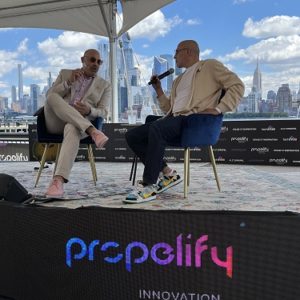The “Secret Sauce” of Trademarks Discussed at VANJ Event
Trademarks get no respect, said Susan Okin Goldsmith of SorinRoyerCooper (East Brunswick), but it’s important for young tech companies to choose their trademarks wisely and then protect them. Many don’t, because they don’t understand why they are important.
In the U.S., protection lasts as long as a company uses a trademark, Goldsmith noted. “The trademark is the name you give your invention, the way you sell your work, your ‘secret sauce,’ the whole package that goes to market,” she said.
Goldsmith spoke to about 60 attendees at a Venture Association of New Jersey’s (VANJ) April 2012 luncheon meeting in Whippany. Jay Trien, of Trien Rosenberg Weinberg Ciullo & Fazzari (Chatham, N.J.) and VANJ president, joked that VANJ often gets lower turnouts at lawyers’ talks, but he noted that what attorneys have to say keeps young companies in business.
Trademarks are not patents, trade secrets or copyrights, said Goldsmith. “Protection of trademarks is really different.” She then briefly reviewed each method of protecting intellectual property.
Sales, Goldsmith explained, depend on how well you are known in the marketplace, and trademark protection helps people know that a product comes from you and not somebody else. A trademark tells the world what company is the source of that product.
Trademarks can be domain names, logos, distinctive restaurant decor or packaging, but they can’t be common industry names or terms, because competitors need to be able to use those same words to describe their goods and services.
When companies choose marks, they should look for distinctiveness. Distinctive trademarks are categorized as fanciful, arbitrary or suggestive. The name “Xerox,” for example, is a completely made up, or fanciful, mark; “Apple” is an arbitrary trademark, a familiar term used for something different than what you’d expect; and “Coppertone” is a suggestive trademark in that it suggests what happens when you use the product.
Less distinctive trademarks, like “1-800-FLOWERS,” are more difficult to register. “If you use them long enough and protect them, you can get a registration,” she said, but that’s expensive.
Promoting trademarks through thoughtful advertising, and then defending them, is key. Aspirin, for example, used to be a strong trademark but then became the word people use to describe the pain-relief product.
Many people think of symbols when they think about trademarks, but symbols that are not distinctive are considered difficult to protect. “You won’t get much protection for these unless you spend an enormous amount of money,” she noted.
What does a young company get from trademark protection? The first user of a symbol—including words, phrases or designs—who gets customers to associate a product with that symbol is permitted by law to stop a junior user from co-opting that symbol or a similar one for the same or a similar product or service, Goldsmith said.
U.S. rights are based on use, not registration, but the huge benefit of registering is that the law provides national rights, as opposed to market-penetration protection only, when you do so. In the U.S., protection can last as long as a company uses a trademark.
“In other countries you get nothing until you register. That’s something to keep in mind as you start to look outside the U.S.,” said Goldsmith. In either case, you don’t get a monopoly on your word. Look at “Delta Dental,” “Delta Faucets” and “Delta Airlines.” All include the word “Delta” but do very different things and do not compete against one another.
“How do you go about choosing a name?” Goldsmith asked the group. “The first thing you need to do is brainstorm. I always encourage people to focus on the words first, because you choose a domain name based on a word, not a symbol.”
Easiest to register are suggestive names like “Coppertone,” but they are very difficult to come up with. It’s easier to pick something from mythology or an unusual place, like the Amazon.
Or you can summarize your mission statement. “This is really, really difficult to do,” Goldsmith said, but “if you are able to do it, it is very powerful.” “Audible” is one example. The name summarizes its mission statement because the company makes audio books.
Another way to create a unique name is to truncate a word, as in the case of shortening “alleviate” to “Aleve.” “Please make it pronounceable,” Goldsmith implored. You can also combine familiar terms in unique ways, like “blueduck” or “redhat.”
What not to choose can be just as important a consideration as what to choose. Don’t choose a misspelling of a common term in your industry, Goldsmith advised; you will find it hard to stop anyone else from using that name.


